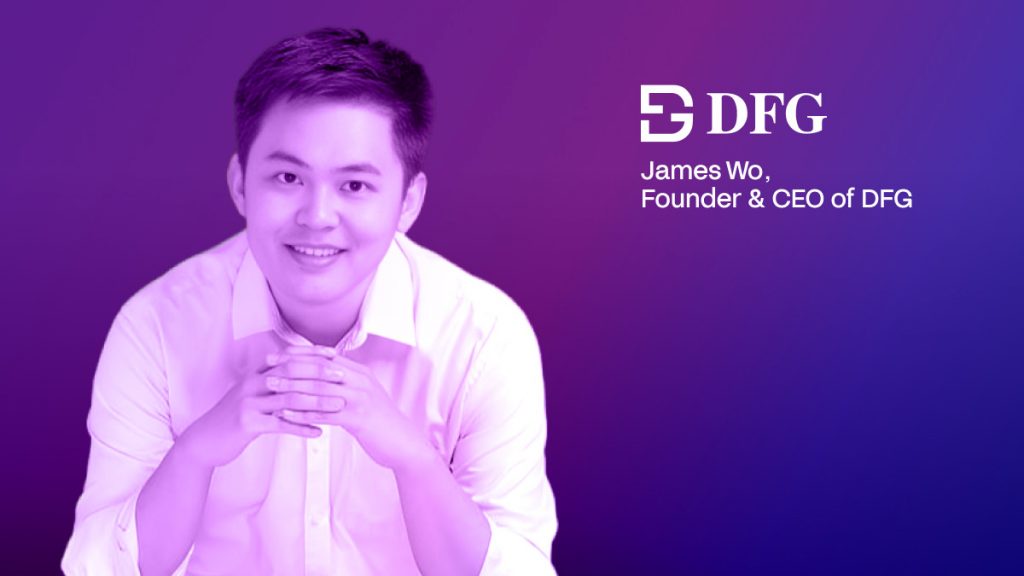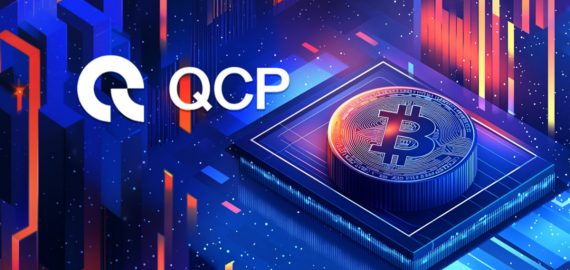The Art of Crypto Fund Management: James Wo on Balancing Tech Expertise, Market Trends, and Investment Discipline


In Brief
James Wo, CEO of Digital Finance Group, shares his strategic approach to crypto investing, focusing on infrastructure plays and AI integration, providing insights into the industry’s past, present, and future.

During the Hack Seasons Conference, we had the privilege of sitting down with James Wo, the Founder and CEO of Digital Finance Group (DFG). With a decade of experience in the crypto space and a billion-dollar fund under management, Wo offers a unique perspective on the industry’s past, present, and future. From infrastructure plays to AI integration, Wo’s strategic approach to crypto investing provides a glimpse into the mind of an experienced industry expert.
Many entrepreneurs are drawn to their field by a specific moment or event. What was your journey to Web3?
I actually started with Bitcoin back in 2013 when I heard about it from a schoolmate. I was still an undergraduate student at that time, pretty early days. We randomly talked about Bitcoin and it was very interesting. I bought my first Bitcoin exactly a decade ago in 2014. At first, I lost some money because it was a bear market. But eventually, I dug deeper into Bitcoin and thought, “Okay, this is something pretty interesting.”
I started DFG back in 2015 with support from my mom. We started with a $20 million fund at that time. It was 100% like a family office with no outside capital. I started deploying more capital in 2016 and 2017. We invested in a bunch of early-stage projects at that time, like Circle, Brave, and BitSo. They’re all unicorns right now.
Can you share your investment strategy in more detail?
We invested in Layer 1 protocols during the period between 2018 and 2019. We invested in Solana, Polkadot, Near, and a few other Layer 1 protocols in their early stages. At that time, valuations were super low. These kinds of projects generated a lot of returns for DFG.
We really enjoyed the bull market in 2021. But we also made another mistake in 2021 because we were a little bit too diversified. We invested in more than 100 different projects across basically all sectors. This was actually too many because we couldn’t allocate our capital properly without doing enough due diligence. Not all the projects were very good. It also brought us a lot of challenges because we had so many portfolio companies to manage.
During the last two or three years, we changed our approach a bit. We’ve been investing more strategically in the primary market. We do probably one deal a month or every two months. We’re putting somewhere between $1 million to $5 million into one deal, being very strategic and supporting these deals. We’re especially focused on mid to later-stage infrastructure, Layer 1, and Layer 2 investments. That’s where we are right now.
Overall, we manage about a billion dollars. Most of our assets are liquid assets, 80% liquid assets on the secondary market. But we’re still looking for good projects in the primary market to invest in.
What is your portfolio more focused on?
Because of our check size, order, and expertise, DFG focuses mostly on infrastructure and protocol-level projects. I think there are still a lot of problems that have to be solved in this area. Scalability issues and other problems haven’t been solved yet, so there’s great potential for infrastructure to mature in the future.
Another reason we’re investing in this sector is our expertise. We have a pretty strong tech team reviewing all the code. Our expertise is more on the infrastructure side. We don’t have the background to be experts in investing in games or different types of protocols. We’re not from a gaming or financial background. So that’s a good reason why we’re really focused on infrastructure and protocol-level projects.
What lessons did you learn from the early investment in Ethereum?
I think we should be more focused because our time is limited. We cannot be too diversified. This is the obvious lesson that we learned from the last bull market. The other lesson is that we should really be holding tokens from the very beginning.
What do you think about Layer 2 solutions? Are there some developments that you are excited about and if you’re looking for investments in this area too?
Layer 2 is something people talk a lot about. We do have some portfolio companies in Layer 2. The first is Metis Network, which we invested in back in 2021. They’re in the top 10 right now and doing pretty well. Another we’ve invested in recently is called Mode Network. They’re more focused on DeFi Layer 2, using the OP tech framework.
On the Layer 2 side, because there are so many builders creating Layer 2 protocols, you have to find an angle that fits the market’s needs. Otherwise, it doesn’t make sense. You can’t just build another Layer 2 when there are already 100 out there. You need to either have a strong tech framework or target a specific sector, which makes it easier for applications to build on top of your protocol. It has to be more specific and focused for your Layer 2 solution to make sense.
So far, among the top 10, we’re still holding our tokens in $MODE and $METIS. However, we are definitely looking for more good potential Layer 2 projects to invest in.
Are you thinking about investing in AI?
We are very excited about the AI narrative. I think this will not just be a hot topic for a few months and then disappear. It will be a very long-term narrative for the next decade. Accordingly, we’re investing in a few really good AI projects like Near and Render Network. We’re also investing in Gensyn Network and talking to a few more AI projects to see which ones are good. We will definitely invest in them.
Do you plan to use AI for your investment strategies?
Absolutely. If some AI solutions can solve our problems, for example, trading problems or optimizing our trading on DEXs, we will definitely use them. There is a strong demand for our fund to make better trades because we are basically more of a tech-driven or product-driven fund. We are not traders.
If we want to start allocating our capital to buy a certain coin on a certain market, we are not experts. We don’t know how to optimize our trading. If there are any AI solutions that can help us optimize our trading, we will definitely use them.
I’m pretty sure other investment funds have similar demands. That’s only one specific sector where AI can solve problems. There will be tons of others that will benefit firms in the industry.
How do you approach risk management, especially with the recent market volatility in crypto?
First of all, we take a long-term strategy. In that way, we control our risk because we are not affected by short-term pumps and dumps. Another way we control risk is by never using leverage. I know some traders are very obsessed with leveraged futures trading, but that adds a lot of risk to their capital or investment money.
We will never touch leverage. Even though the price may go down a little bit in the short term, we’re okay with that. As long as we hold a token for a long time and the project has value. Eventually, we will be the winner.
What do you think about CBDCs and the crypto ecosystem? Do you think CBDCs will have an impact on the crypto market?
I think stablecoins are definitely one of the most important things in the market. Eventually, you need people to come from outside the crypto industry to be investors in Bitcoin, Ether, and all the other projects. This is important.
Since there’s a lack of support from banks and financial institutions directly in the crypto industry, stablecoins are an important intermediary for these investors to move into the industry.
What do you think about memecoins?
We never touch memecoins. I don’t think they have long-term value because we are more like long-term investors. But traders or retail investors might want to get a super good return in the short term and be willing to gamble. They might buy some memecoins as a speculative play.
However, memecoins serve as an important way for crypto to gain adoption. People know about Bitcoin, and they may know about other memecoins like DOGE or PEPE. So, retail investors, at least through these memecoins, get a sense of what crypto is. Then afterward, they can learn more about the crypto industry.
You mentioned that you focus on infrastructure as a fund. What potential do you see in the DeFi sector? How do you position your company in this industry?
We did invest in one DeFi protocol called Parallel. In the DeFi sector, it doesn’t make sense to put everything into crypto. I don’t think that works. There are a lot of crazy projects trying to do DeFi, but many are just ideas and not actually feasible.
I think there are certain sectors where it makes sense to combine with crypto. So it really depends on which DeFi project and which sector you are building. Then we will probably invest accordingly. Unless you give us a very feasible solution or a very realistic way to make it work, I don’t see why I’m going to invest in all these DeFi projects.
Can you highlight any notable investment successes or lessons learned from your past investments?
The best investment is always buying Bitcoin. The Bitcoin I bought back in 2014 has been the best investment in the world. Of course, there are other investments. We bought Render in 2021 when the price was extremely cheap, and right now, we’ve got a 100x return on that project. Part of the reason is that the team is so great, and they’re building an excellent product.
The other reason why we can get 100x returns is that we hold it from day one to the end. If you sell the tokens when you first get them, then you won’t get that return. So I think the successes and lessons we’ve learned all come down to one conclusion: selecting good projects and holding the tokens for the long term.
Can you also share the fund’s roadmap? What are your plans?
Our vision is really to manage more assets with as few people as we can. We want a small, efficient team to manage all the big assets. Right now, we have a billion dollars under management, and we’re aiming for a much bigger AUM in the future, maybe 5-10 billion dollars in the next few years. So, we really want to reach the next level of assets under management and support the fund in the long term. That’s our vision.
Disclaimer
In line with the Trust Project guidelines, please note that the information provided on this page is not intended to be and should not be interpreted as legal, tax, investment, financial, or any other form of advice. It is important to only invest what you can afford to lose and to seek independent financial advice if you have any doubts. For further information, we suggest referring to the terms and conditions as well as the help and support pages provided by the issuer or advertiser. MetaversePost is committed to accurate, unbiased reporting, but market conditions are subject to change without notice.
About The Author
Victoria is a writer on a variety of technology topics including Web3.0, AI and cryptocurrencies. Her extensive experience allows her to write insightful articles for the wider audience.
More articles

Victoria is a writer on a variety of technology topics including Web3.0, AI and cryptocurrencies. Her extensive experience allows her to write insightful articles for the wider audience.

















































